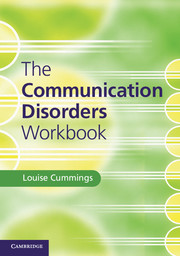Book contents
- Frontmatter
- Contents
- Preface
- Acknowledgements
- List of data analysis exercises
- Chapter 1 Introduction to communication disorders
- Chapter 2 Developmental speech disorders
- Chapter 3 Developmental language disorders
- Chapter 4 Communication disorders in mental illness
- Chapter 5 Acquired speech disorders
- Chapter 6 Acquired language disorders
- Chapter 7 Disorders of voice
- Chapter 8 Disorders of fluency
- Chapter 9 Hearing disorders
- Answers to questions and exercises
- Glossary
- References
- Index
- References
Chapter 3 - Developmental language disorders
Published online by Cambridge University Press: 05 June 2014
- Frontmatter
- Contents
- Preface
- Acknowledgements
- List of data analysis exercises
- Chapter 1 Introduction to communication disorders
- Chapter 2 Developmental speech disorders
- Chapter 3 Developmental language disorders
- Chapter 4 Communication disorders in mental illness
- Chapter 5 Acquired speech disorders
- Chapter 6 Acquired language disorders
- Chapter 7 Disorders of voice
- Chapter 8 Disorders of fluency
- Chapter 9 Hearing disorders
- Answers to questions and exercises
- Glossary
- References
- Index
- References
Summary
For many children, the acquisition of language does not follow a normal developmental course. For the child with developmental phonological disorder (DPD), the simplification processes which are found in immature speech do not resolve spontaneously as they do in typically developing children. As a result, the child with DPD may persist in using forms such as [tat] for ‘cat’ (fronting), [peɪn] for ‘plane’ (consonant cluster reduction), and [dɔ] for ‘dog’ (final consonant deletion) beyond the chronological age at which these phonological processes normally resolve. Often, there is no clear reason why phonological immaturities and deviances persist, and the child displays normal development in other language and non-language areas.
The child with specific language impairment (SLI) may also have phonological problems, but will additionally present with severe deficits in morphosyntax and semantics. These deficits are not related to hearing loss, emotional disturbance, intellectual disability or any of the other factors which are known to predispose a child to language disorder. Moreover, the developmental delay is specific to language, with performance in other areas within the normal range. A subgroup of children with SLI has significant deficits in pragmatics and is labelled as having ‘pragmatic language impairment’.
- Type
- Chapter
- Information
- The Communication Disorders Workbook , pp. 23 - 57Publisher: Cambridge University PressPrint publication year: 2014



